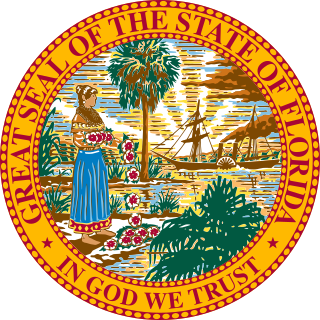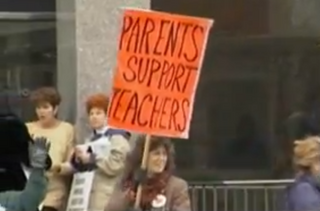Related Research Articles

The National Education Association (NEA) is the largest labor union in the United States. It represents public school teachers and other support personnel, faculty and staffers at colleges and universities, retired educators, and college students preparing to become teachers. The NEA has just under 3 million members and is headquartered in Washington, D.C. The NEA had a budget of more than $341 million for the 2012–2013 fiscal year. Becky Pringle is the NEA's current president.

The American Federation of Teachers (AFT) is the second largest teacher's labor union in America. The union was founded in Chicago. John Dewey and Margaret Haley were founders.

Robert Martinez is an American retired politician who served as the 40th governor of Florida from 1987 to 1991. A member of the Republican Party, Martinez was the first person of Spanish descent to be elected governor of Florida.

Claude Roy Kirk Jr. was an American businessman and politician who served as the 36th governor of Florida from 1967 to 1971. A Republican for most his career, he was the first Republican governor of Florida since Reconstruction.

New York State United Teachers (NYSUT) is a 600,000-member New York state teachers union, affiliated since 2006 with the American Federation of Teachers (AFT), the AFL–CIO, and the National Education Association (NEA). NYSUT is an umbrella group which provides services to local affiliates in New York state; lobbies on the local, state and federal level; conducts research; and organizes new members.

The California School Employees Association (CSEA) is the largest classified school employees labor union in the United States. CSEA represents a quarter million classified public school employees in California.
The Ontario Secondary School Teachers' Federation is a Canadian trade union which represents 60,000 members across Ontario.
The Ohio Federation of Teachers (OFT) is a statewide federation of unions in Ohio, affiliated with the American Federation of Teachers (AFT), AFL–CIO.
The Montana Federation of Public Employees(MFPE) is a Montana labor union. Its 23,000 members make it the largest union in the state.

The Florida Education Association (FEA) is a statewide federation of teacher and education workers' labor unions in the US state of Florida. Its 145,000 members make it the largest union in the state. It is a merged affiliate of the American Federation of Teachers (AFT) and the National Education Association (NEA), and is a member of the AFL–CIO.
United Teachers of New Orleans (UTNO) is a labor union representing teachers and other educational workers in New Orleans, Louisiana, United States. It is an affiliate of the Louisiana Federation of Teachers (LFT), American Federation of Teachers (AFT) and the AFL-CIO.

Politics of Florida reflect a state that has experienced conflict between its liberal southern region and its traditionally conservative northern region. Politics often revolve around budgeting and how money for budgets should be raised.
The Utah Education Association (UEA) is the largest public education employees' union in the U.S. state of Utah, representing more than 18,000 teachers. It has local affiliates in 41 school districts, Applied Technology Colleges, and the Utah Schools for the Deaf and the Blind in Ogden. It is the state affiliate of the National Education Association.
Helen Dickerson Wise is a retired American politician and public education official. A former member of the board of trustees of Pennsylvania State University and past president of the Pennsylvania State Education Association and the National Education Association, she was also a Democratic member of the Pennsylvania House of Representatives.
The Putting Students First Act is an act passed by the Legislative Assembly of Ontario. The law allows the provincial government to set rules that local school boards must adhere to when negotiating with local unions and to impose a collective agreement on the board, employee bargaining agent, and the employees of the board represented by the employee bargaining agent if negotiations are not completed by December 31, 2012. This bill also limits the legality of teachers' unions and support staff going on strike. In April 2016, the law was found to be unconstitutional.

The West Virginia teachers' and school personnel strike began on February 22, 2018, with a call from the West Virginia branches of the American Federation of Teachers and the National Education Association, and the West Virginia School Service Personnel for school employees across West Virginia to strike. The strike, called in response to anger among teachers and other school employees over low pay and high health care costs, involved roughly 20,000 teachers and public school employees and shut down schools in all 55 West Virginia counties, affecting some 250,000 students. It lasted until March 7, 2018.
The 2018 Oklahoma teachers' walkout began on April 2, 2018, with teachers across the state walking out to protest low pay, overcrowded classrooms, and tax cuts that resulted in lower state-wide education spending. It was the first such action in Oklahoma since 1990. The OEA declared an end to the walkout on April 12 after an agreement to increase salaries and state funding for education was reached. The call to end the walkout faced some objection from teachers and parents who did not believe that enough concessions were made by lawmakers.

The 1997 Ontario teachers' strike was a labour dispute between the government of Ontario under Premier Mike Harris of the Progressive Conservative Party of Ontario (PCs), and the Ontario Teachers' Federation (OTF) and its member labour unions. The strike occurred in the context of Harris' Common Sense Revolution, a program of deficit reduction characterized by cuts to education and social services. In September 1997, the PCs introduced Bill 160, which sought to reduce education spending and transfer numerous aspects of school administration from local school boards to the provincial government. In response, teachers participated in a province-wide walkout beginning on October 27, 1997.
From 1968 to 2012 at least 839 teacher strikes have occurred in the US. 740 of these have been in Pennsylvania. Teacher strikes and walkouts have since increased in popularity outside of Pennsylvania due to the Red for Ed movement in 2018-19.

The Hillsborough Classroom Teachers Association is union representing teachers within the Hillsborough County, Florida School District.
References
- Berry, Mike. "Teacher Unions Want to Join Forces". Orlando Sentinel. June 6, 1998.
- Farrell, Jodi Mailander. "1968 Strike a Landmark for Schools". Miami Herald. February 2, 1998.
- Fish, Sandra. "School Crisis Echoes '67 Deadlock". Orlando Sentinel. March 16, 1992.
- Hopkins, John. "A Review of Events in Professional Negotiations". Theory Into Practice. 4:2 (April 1965).
- Kleindienst, Linda. "Merged Teacher Union Is Poised for Education Battle". Orlando Sentinel. June 19, 2000.
- Mailander, Jodi. "From Teacher to Union Boss". Miami Herald. September 17, 1996.
- Noll, Jody Baxter. "'We are Not Hired Help': The 1968 Statewide Florida Teacher Strike and the Formation of Modern Florida". Florida Historical Quarterly. 2016.
- Park, Paula. "The Old School of Power". Miami New Times. September 19, 1996.
- Rado, Diane. "For Florida Schools, 'Mr. T' is King of Blackboard Jungle". St. Petersburg Times. September 24, 1996.
- Selden, David. The Teacher Rebellion. Washington, D.C.: Howard University Press, 1985. ISBN 0-88258-099-X
- Talalay, Sarah and Kleindienst, Linda. "Unions Seek Strength in Numbers". Ft. Lauderdale Sun-Sentinel. May 21, 1999.
- "Teachers' Boycott". Time. August 17, 1962.
- Thomas, Kevin. "25 Years After Strike, Schools Still at Issue". St. Petersburg Times. February 21, 1993.
- "Walkout in Florida". Time. March 1, 1968.